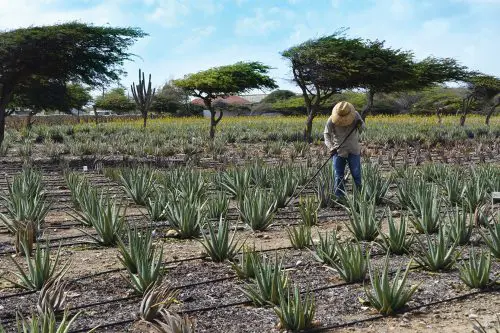Aloe has been revered for thousands of years, celebrated for its healing, health, and cosmetic benefits. From Cleopatra to modern-day beauty aficionados, aloe continues to be a timeless, natural remedy. Aruba is not only famous for its pristine beaches but also for its flourishing aloe production, making it a significant part of the island’s history and economy.
The History of Aloe
Aloe, a genus of succulent plants, includes hundreds of species, but Aloe vera is the most popular. Its origins trace back to northern Africa, and its name comes from the Arabic word “alloeh,” meaning “bitter,” a nod to the plant’s bitter-tasting sap. Aloe’s fame grew in ancient civilizations like Egypt, Greece, Persia, and India, where it was believed to have divine powers, capable of curing ailments and protecting the skin.
Cleopatra famously used aloe gel to maintain her youthful skin and to impress Mark Antony, while Queen Nefertiti reportedly incorporated it into her beauty routine. Aloe’s historical use as an embalming agent is also notable, with its antibacterial and antifungal properties helping to preserve the dead, symbolizing the hope for eternal life.
Aloe in Modern Times
The medicinal benefits of aloe continue to this day. Aloe gel is commonly used to treat burns, skin irritations, and abrasions. It contains essential vitamins like A, C, and E, as well as antioxidants, enzymes, and amino acids, making it a staple in many skincare products like creams, lotions, and shampoos.
Aloe is also utilized in health food products, often incorporated into juices, smoothies, and even salads. Though its benefits for serious conditions like diabetes and asthma are still debated, aloe’s widespread use in herbal medicine continues.
Aloe on Aruba
Aruba’s unique climate and dry soil make it an ideal place for aloe cultivation, with the plant being one of the island’s major exports. Aloe has been a vital part of Aruba’s economy, and in the 1950s, the island accounted for a third of the world’s aloe production. Today, aloe remains an important product, and Aruba continues to export high-quality aloe worldwide.
The Aruba Aloe Museum, Factory, and Store in Hato offers visitors a deep dive into the plant’s history, production, and uses. You can take a guided tour and learn about how this “divine” plant has shaped both Aruba’s past and its future.
Aloe Products in Aruba
In addition to the museum, Aruba boasts several spas and hotels that use aloe in their treatments, especially for after-sun relief. The island’s own aloe-based lotions are perfect for soothing sunburned skin after a day on the beach.
So, whether you’re indulging in a spa treatment, shopping for aloe products, or simply enjoying Aruba’s sunny beaches, you’re experiencing the magic of this extraordinary plant. Its health and beauty benefits will stay with you long after your visit to One Happy Island.
Photo credits : https://www.myarubaguide.com/blogs/land-of-aloe-arubas-divine-plant























Discussion about this post